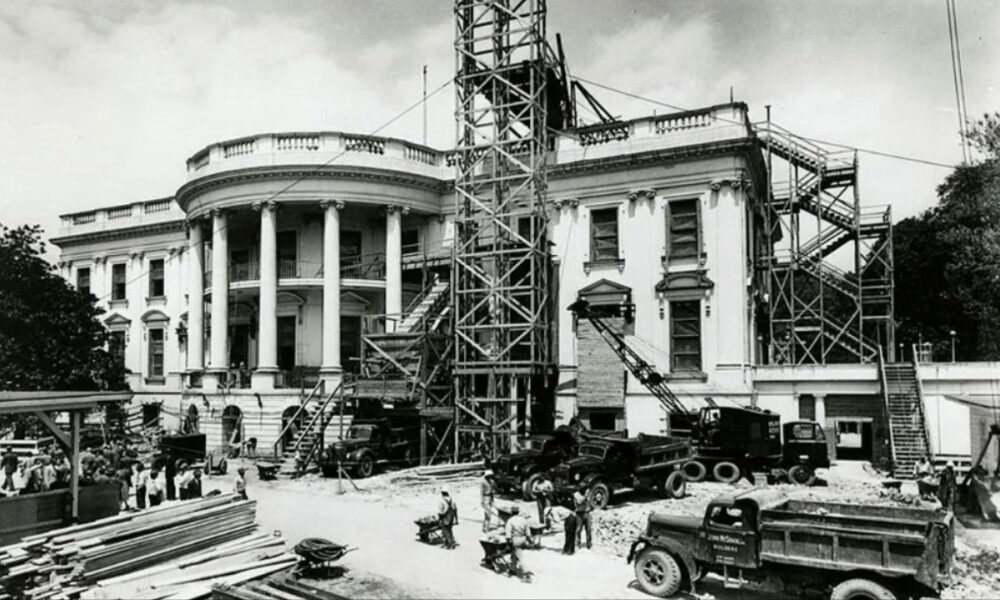As President Donald Trump’s $200 million ballroom project gains viral attention, the White House’s long history of renovations has come back into the spotlight.
“Since the last major renovation by Harry Truman, every president and first lady has made changes inside the White House but in very different ways,” per The White House Historical Association.
Let’s take a look at the significant transformations that have defined the iconic residence throughout the centuries, from its origins to the most recent plans for Trump’s East Wing addition:
1789–1800: Building a Presidential Home
Under the oversight of President George Washington, construction of the White House began in 1792, based on a classical design by Irish architect James Hoban. Completed in 1800, it welcomed President John Adams as its first resident.
1814–1817: Rising from the Ashes
The War of 1812 saw British forces burn down the Capitol, the White House, and a few other federal buildings in 1814, leaving them in ruins. Hoban led the rebuilding effort, finishing in 1817. He later added the South Portico in 1824 and the North Portico in 1829 with the design help of Benjamin Henry Latrobe.
1881: Arthur’s Victorian Makeover
President Chester Arthur brought in a Victorian aesthetic to the White House, installing a lavish Tiffany screen in the Entrance Hall. To fund the changes, according to Architectural Digest, Arthur auctioned off much of the existing furniture, leaving his bold mark on the interior.
1902: Roosevelt’s West Wing Expansion
President Theodore Roosevelt commissioned McKim, Mead and White to modernize the White House, adding the West Wing for presidential offices. The construction and design firm stripped away Arthur’s Victorian details, restoring a more “unified” and classical aesthetic to the residence.
1909: Taft’s West Wing Remodel
President William Howard Taft would remodel and expand the West Wing and begin construction on what would become America’s first Oval Office.
1913: Wilson’s Rose Garden Modernization
President Woodrow Wilson demolished the colonial garden, “modernizing” it with a rose garden.
1927: Coolidge’s Upper Floors Renovation
President Calvin Coolidge oversaw the renovation of the upper floors and attic of the White House.
1929–1930: Hoover’s West Wing Remodel and Fire Repair
President Herbert Hoover remodeled the West Wing, including reconstruction of the basement level and remodeling of the first floor; after a fire on Christmas Eve 1929, the West Wing was repaired and reopened in 1930.
1934: FDR’s West Wing Overhaul
President Franklin D. Roosevelt overhauled the West Wing, adding a second floor, a larger basement, and a swimming pool, while also relocating the Oval Office to its current location.
1942: East Wing and Secret Bunker
Franklin D. Roosevelt oversaw the addition of the East Wing, designed to conceal the Presidential Emergency Operations Center, an underground bunker. Today, the wing primarily houses the First Lady’s office and staff workspaces.
1948–1952: Truman’s Structural Rebuild
By 1948, the White House faced a structural collapse, prompting President Harry Truman to start a four-year interior reconstruction project. The project relocated the Truman family to Blair House until 1952, resulting in the iconic framework that supports the building today.
1961: Jacqueline Kennedy’s Historic Restoration
First Lady Jacqueline Kennedy, with designers Sister Parish, Henry du Pont, and Stéphane Boudin, aimed to restore some of the White House’s “historical integrity.” Sourcing artifacts from museums and prominent families across the country, she showcased a collection of items reflecting America’s history throughout the building, presenting the changes in a 1962 televised tour that earned an honorary Emmy.
1962: Kennedy’s Modern Rose Garden
President John F. Kennedy constructed the modern Rose Garden, designed by Rachel “Bunny” Lambert Mellon.
1970–1973: Nixon’s Press Room and Bowling Alley
In 1970, President Nixon converted the swimming pool into the press briefing room; in 1973, he also added a bowling alley in the basement.
1975: Ford’s Outdoor Swimming Pool
President Gerald Ford installed an outdoor swimming pool on the South Grounds, funded entirely by private donations.
1979: Carter’s Green Innovations
The Carter administration introduced “sustainable” upgrades, including the White House’s first computer and solar water-heating panels. Removed under Reagan, the panels were later reinstalled by President George W. Bush.
2013: Obama’s Modern Oval Office
President Barack Obama worked with designer Michael Smith to completely redesign the Oval Office, attempting to blend historic and contemporary elements. Nicknamed “The Audacity of Taupe” by The New York Times, the subtle design sparked varied reactions for its minimalist approach.
2017: Trump’s First-Term Refresh
In 2017, President Donald Trump oversaw a $3.4 million renovation, updating the Oval Office with new furniture and gold-hued upholstery, alongside more basic HVAC and IT system upgrades.
2025: Rose Garden Transformation
The Rose Garden, designed by Rachel “Bunny” Lambert Mellon in 1962, was recently paved with stone, inspired by Trump’s Mar-a-Lago estate.
Trump’s 2025 Ballroom Project
The current $200 million ballroom, designed by James McCrery II, will add a 90,000-square-foot space with “Gilded Age-inspired” features. Privately funded, the addition—now breaking ground—will boost the White House’s capacity to host larger events. The project primarily affects a small tunnel and covered walkway in the East Wing, aiming to preserve most of the historic structure while creating new space for around 1000 guests.


